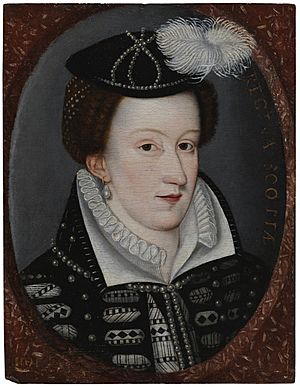Jean de Compiègne facts for kids
Jean de Compiègne (died 1581) was a French tailor. He worked for Mary, Queen of Scots, in both Scotland and England. His name often appears in her records and letters. He was also known as "Jehan Poulliet." He signed his name as "Jehan Poullyet."

Contents
Jean de Compiègne in Scotland
In Scotland, Jean de Compiègne earned money for making the queen's clothes. He also supplied and prepared silk thread. This thread was used for embroidery and other crafts. He worked with Jacques de Senlis, another tailor. Jacques was also a valet, meaning a personal attendant, in the royal wardrobe. Together, they made masque costumes for Mary and her ladies. A masque was a type of entertainment with music, dancing, and costumes.
Making Royal Clothes
Jean de Compiègne's work was written down in French. These records were part of Mary's wardrobe accounts. Servais de Condé, who managed the wardrobe, kept these notes.
One of his first recorded tasks was in January 1564. He prepared canvas to wrap a gift. This gift was likely clothing for Madeleine of Savoy in France. In February 1564, Jean added special decorations to Mary's bonnets. He put three plumes on them. Plumes are decorative feathers. Two of these were black jay feathers for the queen's bonnets.
In September 1564, Jean de Compiègne made a beautiful gown. It was made of black velvet. It was also decorated with pearls. The record says he used "22 ells and a fifth" of velvet. An ell was an old unit of length, about 45 inches.
For a masque in February 1566, Jean de Compiègne made unique costumes. He decorated them with flame shapes. These flames were made from old cloth of gold cushion covers. The outfits were described as "male apparell." During the show, the ladies presented daggers to the French ambassador.
In March 1566, Jean de Compiègne created a silver headdress for Mary. She wore it at the Parliament of Scotland. He also made clothes for Nichola, the queen's entertainer or "fool." He made ruffs, which are ruffled collars, for Lord Darnley. Jean was also given gold thread for embroidery.
In July 1566, he made a gown for Helen Littil. She was the nurse of Prince James. In August 1566, he made a special cover for the Prince. This cover was used to wrap Prince James at his baptism at Stirling Castle. It was made from 10 ells of silver damask. Damask is a rich, patterned fabric. After the ceremony, this fabric was used on a bed.
In February 1567, he was paid under his other name, "Johnne Powlet." He made a cloak and a skirt front for Mary's black mourning clothes. She wore these after Lord Darnley's death. In March, he made mourning clothes for her pages and lackeys. Pages and lackeys were young servants.
Household Service and Daily Life
Jean de Compiègne was also a "valet of the chamber." This meant he was a personal servant in the queen's private rooms. He received clothes to wear in February 1566 and January 1567. The first list of clothes included red and yellow items. These were for his own servant, a lackey. At this time, Jean was making clothes for the queen's pages and lackeys. The clothes in the second list were black and gray. They included an "Almain" or German-style cloak. His servant boy wore clothes made of English blue wool. Jean's wife also worked for the queen. She was a servant in the queen's chamber. Both Jean and his wife received linen at Easter.
In January 1567, an Italian servant named Joseph Lutyni left for Berwick-upon-Tweed. He said he was being chased for a debt of 30 crowns to the queen's tailor. This tailor was likely Jean de Compiègne. Two Italian brothers, Lorenzo and Timothy Cagnioli, supplied fabrics to Mary.
Jean de Compiègne in England
Jean de Compiègne continued to serve Mary even when she was in England. He was with Mary at Sheffield Manor Lodge in 1572. He made a list of fabrics that Mary wanted from France. These were to be brought by a diplomat named Bertrand de Salignac de la Mothe-Fénelon.
In July 1574, Mary hoped to meet Elizabeth I at the English court. She asked her ally in France, the Archbishop of Glasgow, for new items. She wanted coifs, which are close-fitting caps, embroidered with gold and silver. She also wanted the latest Italian ribbons and veils for her hair. She hoped Jean de Compiègne could come to her in Sheffield. Some of these fabrics were meant as gifts for Elizabeth I.
After Jean de Compiègne died in February 1581, Mary wanted to hire Jacques de Senlis as her new tailor. She asked the French ambassador, Michel de Castelnau, to get a passport for him. She also wanted chests of new clothes made to her measurements. Mary's letters show that both Jean de Compiègne and Jacques de Senlis visited her in England. They also made her clothes in France. She wrote to the Archbishop of Glasgow in France. She said, "Cause the clothes to be made by Jacques de Senlis, whom I have resolved to employ in the room of the late John de Compiègne." She added that she had made him "take measure of all my dresses" on his last trip. Jacques de Senlis had even dressed Mary's dolls in Scotland. This was possibly to show new styles.
In later years, Mary's wardrobe master in England was Balthazar Hully. An English tailor, Robert Mooreton, served him. Other French staff stayed with Mary until the end. These included Balthazar, the master tailor, and Charles Plouvart, the embroiderer. There were also three English laundry women from Derbyshire. Their names were Elizabeth Butler, Alice Sharpe, and Alice Forster. Alice Sharpe had married the coachman, Roger Sharpe, who was from Sheffield.

